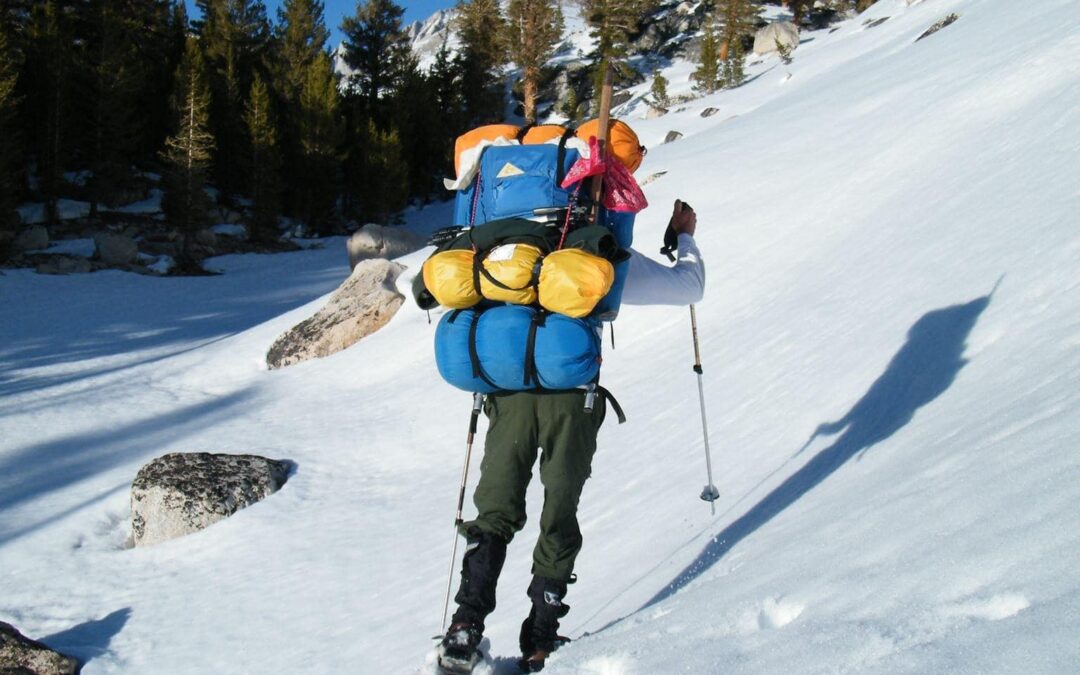Starting today at elevations at or above 11,000 feet, the overnight temperatures will rise above freezing and stay there, meaning…
The Thaw has finally started at PCT/JMT cruise altitudes!
Without the ability to re-freeze at night, the snowpack will probably not hold your weight out in heavy sunlight-exposed areas and postholing may become a “wallow-fest.” Choose over-snow routes under shady cover of trees for the best flotation without postholing.
The pack at these higher elevations will start settling, melting, and consolidating at a very fast rate, possibly dropping 2-6 inches a day in depth. Where compressed under multiple footprints, it can pack-up and solidify into a descent boot-track, but where it’s able to do that depends on factors of wind and radiant heat (or lack there of) from boulders below or underneath it. Where it does or doesn’t may be completely unpredictable, so be constantly evaluating what your standing on and walking over – with each footstep. One step may be able to hold your weight, while the next may not.
🥾The snow will be super-slippery as it thaws out, turns slushy, and melts into flowing waters over dirt and granite on its way to the nearest creek, so don’t get hasty about your foot placements!
🥾Learn to “heel-plunge” or glissade where you can straight down slopes.
🥾Utilize the edges of your shoe’s soles to hold you to traverses.
🥾 Anticipate that your traction devices may fill with snow and become useless at best or skis at worst.
🥾Cornices are going to start falling off the ridges beside and above you, as you sojourn through the High Sierra canyons, starting wet slough avalanches when they impact the steep slopes below them. Look Up, watch for them, and avoid being below all cornices at this early stage of the Thaw at these high elevations above 11,000 feet.
🥾The steep snowpack up by the passes will be getting so wet and heavy that it will be, literally, liquifying right before your eyes! If you see “roller balls” or “pinwheels” spontaneously releasing from the slopes above you and rolling down the mountainsides, seriously consider not going that way. The addition of your own body weight may be enough, especially if you are traversing across steep, wet snow, to release an entire slope and you’ll be, suddenly, riding a heavy, slow-moving avalanche (or getting buried by it).
🥾If your chosen route is not over solid ground, like the trail, itself, but could be over a massive, air-filled, boulder field on the way up to a pass, any postholing under the heat of Thaw conditions could plunge more of your entire body, than just a leg, into air space between boulders beneath you and severe injury could result. Stay on established boot-tracks.
🥾As the snowpack endures an intense Thaw with lots of ambient heat, direct sunlight, radiated heat from boulders in the pack, warm winds under and over it, and, perhaps, little cloud cover, it will become incohesive, lose all is bonds to itself, and move in all directions at any time. Not only is traction extremely important to maintain, but balance over both feet, utilizing two poles with snow baskets, will often become the only technique preventing you from slipping, falling, and tumbling down the mountainside, maybe injuring something along the way.
Don’t make hasty moves on slippery surfaces, even if others have been able to do so. You are different (weight, manner of step placement, type and amount of traction, availability of edges on your shoes, the ability to keep each foot’s pressure evenly distributed across its imprint, etc.).
Remember, self-arrest devices don’t work in soft snow!
The Sierra Thaw is “on” in the High Sierra!
(And I didn’t even begin to talk about the greatest danger at this time – the torrential creek crossings!)
[photo relevance: when the snow gets so “rotten,” even snowshoes may not give you enough flotation to stay on its surface!]

